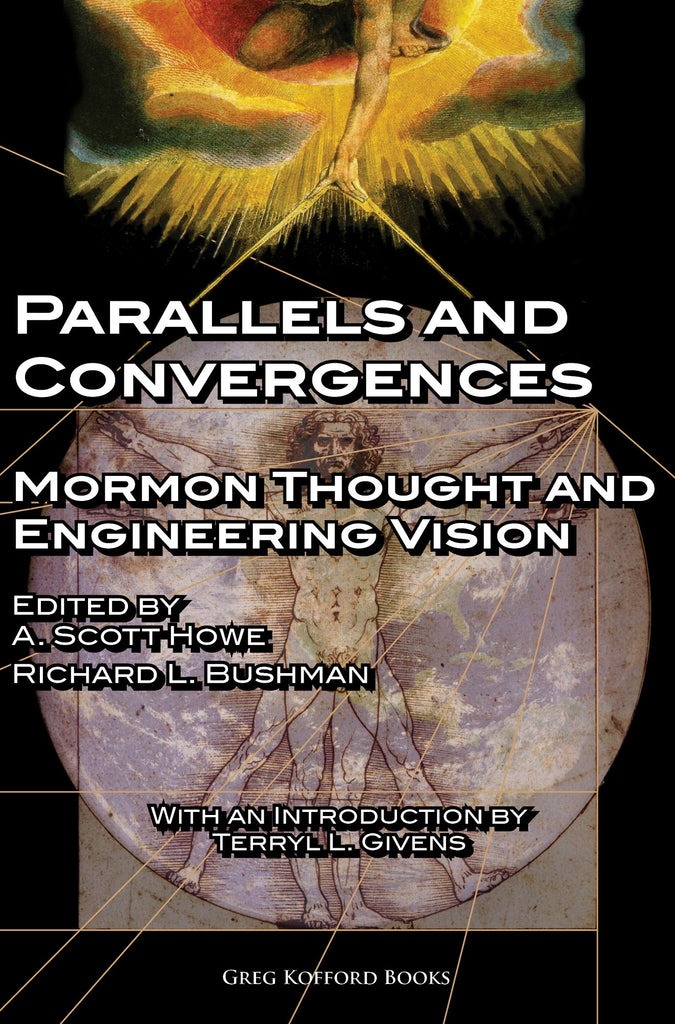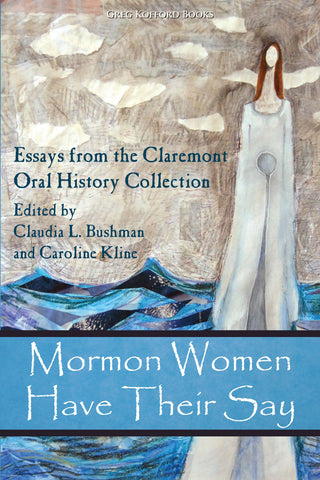Parallels and Convergences: Mormon Thought and Engineering Vision
$24.95
Edited by A. Scott Howe and Richard L. Bushman
- “Marvelous speculations that open up the vision of how beautifully and practically Mormonism can (and probably even should) be wed with our increase in scientific knowledge.” — Improvement Era
- “Consistently takes Mormon scripture and doctrine seriously and then makes conjectures as to how to interpret them in a scientific worldview.” — Millennial Star



Available in ebook for Kindle, Nook, Apple, Google Play, and Kobo.
Also available through Amazon.
Book Synopsis:
The earth will eventually be renewed and receive its paradisiacal glory. But how will our current world ever become the heaven of our dreams? The Lord is already on it; and, as the essays in this book provocatively propose, He’s following good engineering principles.
Joseph Fielding Smith said, regarding inventions in these latter days, “The inspiration of the Lord has gone out and takes hold of the minds of men, though they know it not, and they are directed by the Lord. In this manner he brings them into his service.”
If there is “no such thing as immaterial matter,” and “all spirit is matter,” then what are the implications for such standard theological principles as creation, human progression, free will, transfiguration, resurrection, and immortality? In eleven stimulating essays, Mormon engineers probe gospel possibilities and future vistas dealing with human nature, divine progression, and the earth’s future.
Richard Bushman poses a vision-expanding proposal: “The end point of engineering knowledge may be divine knowledge. Mormon theology permits us to think of God and humans as collaborators in bringing to pass the immortality and eternal life of man. Engineers may be preparing the way for humans to act more like gods in managing the world.”
Comprehensive Table of Contents:
.
Foreword - Richard Lyman Bushman
Introduction - Terryl L. Givens
Section 1 - Parallels in Mormon Thought: Physics and Engineering
1. Models of Spirit Matter
Abstract
Introduction: What We Know
The Mirror Model
Problems with the Mirror Model
Computational Model
Computational Model Problems
Phase Model
Phase Model Problems
Conclusion
2. A Standard Physics Model of Spirit
Abstract
Introduction
Personal Building Blocks
Physical Action Preceded by Spiritual Transaction
The Calculation of Truth
Engineered Agency
Spirit and Physical Bodies
Conclusion
3. A Technical Interpretation of Mormon Physics and Physiology
Abstract
Introduction
A Technical Interpretation of Mormon Physics
A Technical Interpretation of Mormon Physiology
Practical and Moral Drivers for Technical Interpretations
Conclusion
4. Materialism, Free Will, and Mormonism
Abstract
Introduction
Materialism
The Basic Argument
Intelligent Matter
Determinism and Randomness
The Black Box Problem
A Possible Solution and Challenge
Alternatives and Consequences
Conclusion
Section 2 - Parallels in Mormon Thought: Philosophy and Engineering
5. God, the Perfect Engineer
Abstract
Introduction
The Engineering Design Cycle
God’s Creation of the Universe
God Follows Eternal Laws
Jesus Christ Organized the Earth
God Followed a Plan
Engineers May Fail in Their Designs
Can God Fail?
We Need Assurance That God Has Not Failed
God’s Plan Is a Perfect Plan
6. Complementary Aspects of Mormonism and Transhumanism
Abstract
Introduction
What Is Transhumanism?
A Transhumanist View of the Future
A Mormon View of the Future
Transhumanist Parallels with the Mormon View
Transhumanist Complements to the Mormon View
Mormon Complements to the Transhumanist View
Conclusion
7. Quantified Morality
Abstract
Introduction
The Decision Tree
Potentiality Test
Freedom Characterized by Restraint
An Engineering Perspective on Morality
Cause and Effect: Justice Must Be Satisfied
Entropy: A Quantifiable Measure of Order
Order and Structure Expand Future Potential
Musings on a Mathematical Model for Morality
Discussion
Other Points of Discussion
Conclusions
8. Theological Implications of the New God Argument
Abstract
Introduction
The Faith Position
The Angel Argument
The Benevolence Argument
The Creation Argument
Analysis
Conclusion
The New God Argument
Section 3 - Parallels in Mormon Thought: Practice and Engineering
9. Gaia, Mormonism, and Paradisiacal Earth
Abstract
Introduction
Earth Sentience
River Basin Sentience
Columbia River Basin
Co-Creators
Conclusion
10. Spiritual Underpinnings for a Space Program
Abstract
Introduction
Perspective from Economics
Perspective from Energy, Environment, and Infrastructure
Perspective from Planetary Protection
Spiritual Insights
Scriptural Connections
Insights from LDS Church Authorities
Discussion
11. Welcome to the Twenty-First Century:The Uncharted Future Ahead
Abstract
Introduction
A Brief History of the Past Fifty Years
Overview of Recent and Future Developments
Ethical, Moral, and Social Issues
The Idea of Progress in LDS Thought
Conclusion
Contributors
Scripture index
Index
From the foreword by Richard L. Bushman:
Mormon theology leads us to see eternal implications in engineering. Engineers enable us to make the world more comfortable and to perform incredible feats of movement and communication. But their work may go beyond the amelioration of the human condition. The end point of engineering knowledge may be divine knowledge. Mormon theology permits us to think of God and humans as collaborators in bringing to pass the immortality and eternal life of man. Engineers may be preparing the way for humans to act more like gods in managing the world.
Kindliness, wise parenting, righteousness, and service are probably more fundamental in leading humans toward eternal life. But improving our physical world fits serves divine purposes, too. In constructing better worlds, engineers may be learning godly skills. From a Latter-day Saint perspective, they may be incipient creators.
The papers in this volume capture the thought of a group of LDS engineers exploring the interactions of their work and their belief at the beginning of the twenty-first century. Ideally these essays will launch a discussion that will continue for many years to come.
Praise for Parallels and Convergences:
“It's a book of marvelous speculations that open up the vision of how beautifully and practically Mormonism can (and probably even should) be wed with our increase in scientific knowledge.” — David Tayman, Improvement Era
“[Parallels and Convergences] was much of what I was hoping for…It consistently takes Mormon scripture and doctrine seriously and then makes conjectures as to how to interpret them in a scientific worldview. It then points out its own failures and looks towards a future improved conjecture.” — Bruce Nielson, Millennial Star
“This book is recommended for those who want to delve in to the congruence found between Mormonism and transhumanism. The essays are often not definitive, but speculative, in describing new ways of thinking about both Mormonism and transhumanism. The book is especially useful for readers who already subscribe to the tenets of a religion founded in 1830 in upstate New York or a philosophy that expects computers and other technologies to soon completely change what it means to be human.” — Eric Swedin, Novo Religio: The Journal of Alternate and Emerging Religions
About the Editors:
A. Scott Howe is a Senior Systems Engineer for NASA Jet Propulsion Laboratory, specializing in robotic construction for space environments. In addition to numerous peer-reviewed journal and technical papers on robotics, he is the editor, with Brent Sherwood, of Out of This World: The New Field of Space Architecture, in the AIAA History of Spaceflight series.
Richard L. Bushman is Gouverneur Morris Professor of History Emeritus at Columbia University and former Howard W. Hunter Chair of Mormon Studies at Claremont Graduate University. His books include Joseph Smith and the Beginnings of Mormonism and Joseph Smith: Rough Stone Rolling.
More Information:
210 pages
ISBN: 9781589581876 (Paperback)
Published February 2012






Share this item: